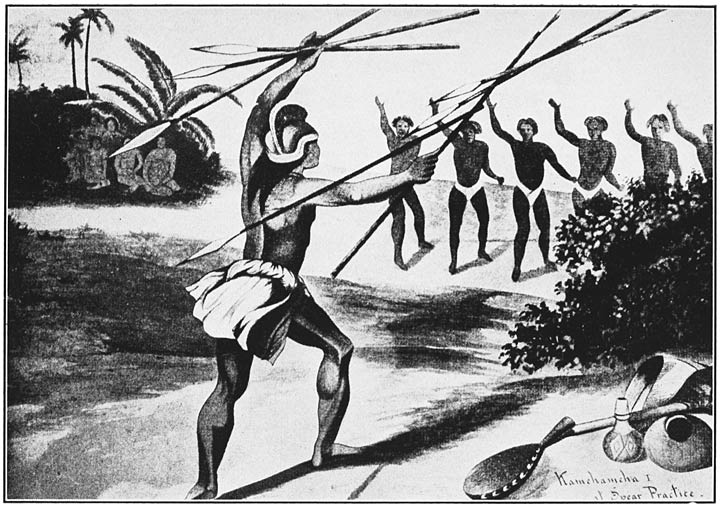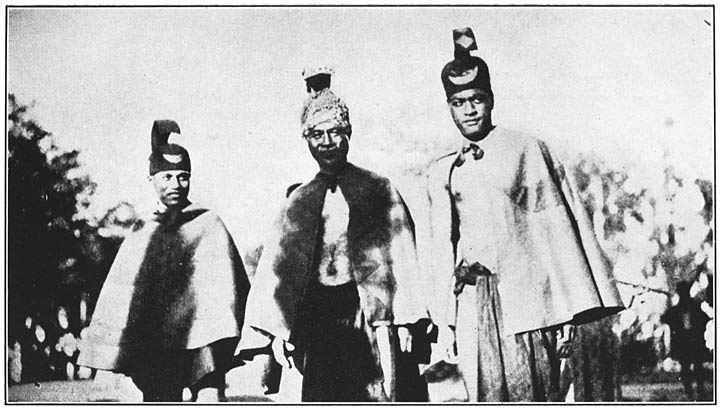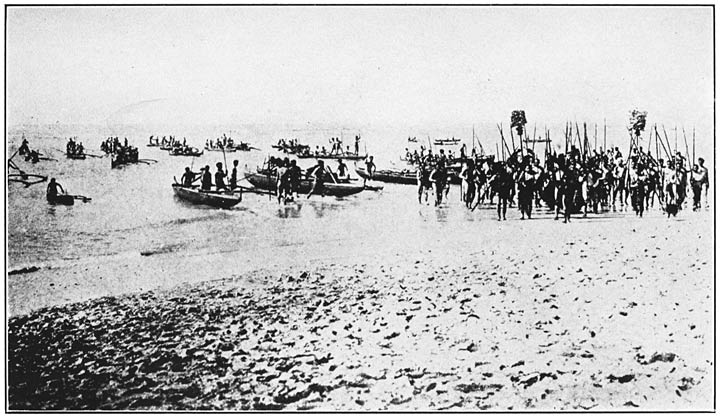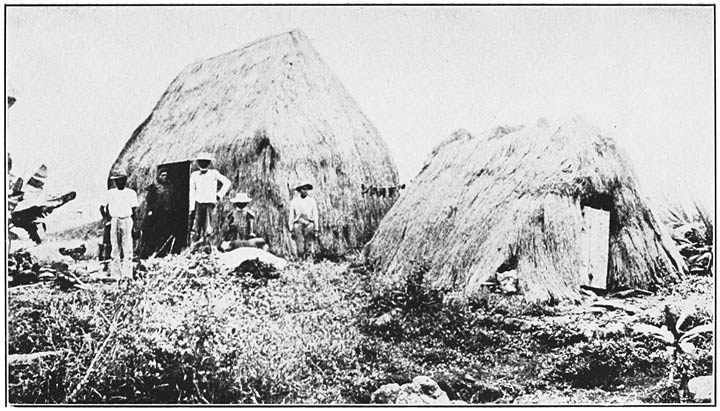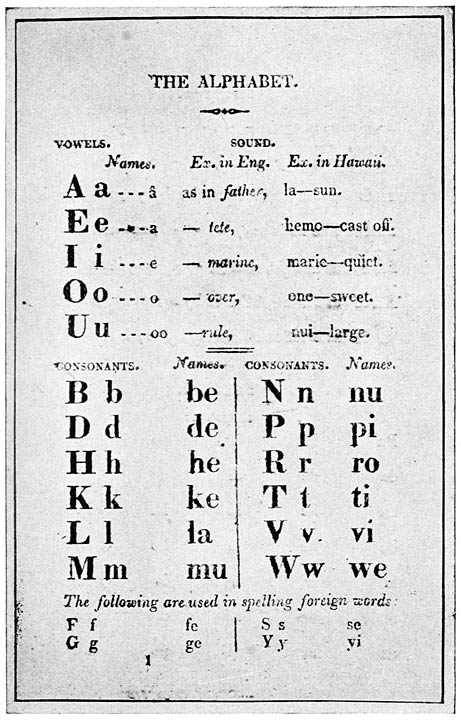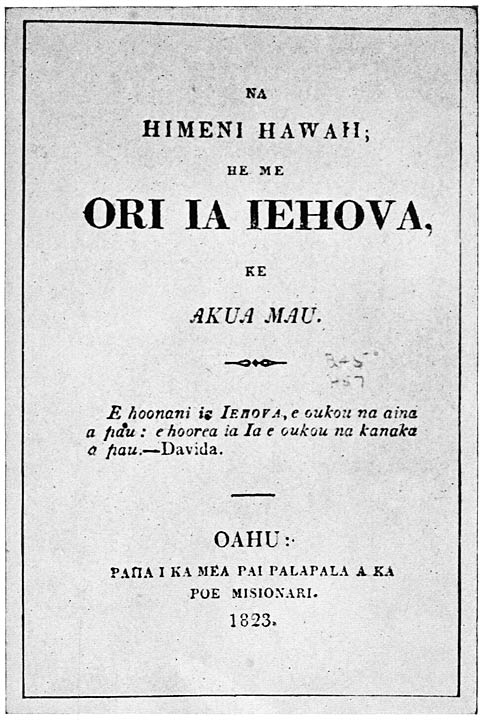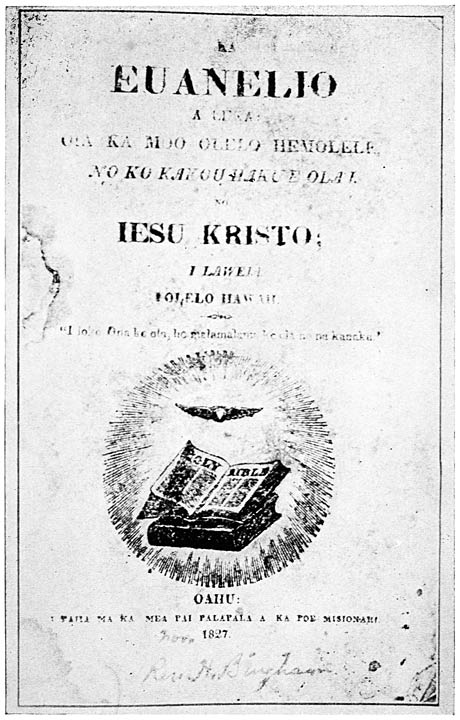Ka-meha-meha is the chief name around which Hawaiian history gathers. It is the nimbus
of a cloud of stories, legends and chants. Hawaiians never reckoned history by dates,
but by genealogies—as did the Hebrews. They measured time not by the years but by
the lives of men; not by the days passed, but by the deeds done. These genealogies
formed the most essential part of Hawaiian literature. They proved the royal descent
of the high chiefs.
When Ka-meha-meha became king of “The Rainbow Islands,” his royal chant took the supreme
place. Other genealogies lost their importance except as they blended in that of the
great king. He traced his royal blood to Pili, “from a foreign land,” and through
Pili back to Wa-kea, a Polynesian chief of perhaps the second century; and thence
back through a series of hero-gods to Kumu-Honua, “the first created.” It is a remarkable
genealogy and worthy of study.
In November, 1736, he was born in North Kohala, Hawaii. Pili had settled in North
Kohala [66]about thirty generations preceding. A quarter of a century is accepted as the average
life of a generation. Pili, therefore, landed in Hawaii in the early part of the eleventh
century.
The story of Pili depends upon another story which must be told first. In fact the
Hawaiian traditions tell a great deal more about Paao, the founder of the high-priest
family of Hawaii, than about Pili, the ancestor of kings.
Not far from the year 1100 A.D., two priest brothers were living on Upolu, one of
the Samoan Islands. Lonopele, the elder, lived in one of the luxurious valleys opening
upon the seacoast. Paao, the younger, was a seaman as well as a priest. He lived near
the beach, where he kept a small fleet of canoes.
In some way bitter feeling arose between the two households, making them jealous and
suspicious of each other. One day Lonopele came to the temple where his brother was
making ready to sacrifice a sacred black hog.
“Where are you, O Paao,” he cried, “that you prepare a sacrifice for the favour of
the gods, when you do not watch your oldest boy?”
“What is your thought?” asked Paao.
“Some of my choice fruits, brought from Tahiti, are beginning to ripen; and each night
Kaino, your son, creeps under the low branches, and gathers whatever is good.”
“It is false!” angrily replied the father.
[67]
Theft was considered the greatest of crimes among the Polynesians.
“No! It is true. He is coming even now from his feast. If he touches my fruit again
he shall die. It is tabu” (sacred).
“E! Kaino!” called the father.
The boy came near, evidently having just been eating.
“Have you taken fruit from Lonopele in the night?”
“No. I have fruit at home, but better are the baked dog and fish. I would not eat
his fruit.”
Lonopele became angry, and cried out: “May the god, Kanaloa, curse you and break your
body into fragments, for your falsehood.”
“Cut open my stomach, O my uncle, and I shall be proved innocent.”
The ancient days had little of the modern care for children. Fathers and mothers readily
gave away their babes, or slew them with their own hands. Paao determined to substitute his son for the sacrifice he was preparing, and thus prove
his guilt or innocence. No trace of fruit was found in the body.
Lonopele bowed his head in shame and hastened away. When the flush of indignant anger
had passed, Paao grieved over the body which lay decomposing upon the altar. The Hawaiian
traditions say that after this act he determined to leave Upolu. He called together
a few of his trusted [68]friends and told them his purpose. They agreed to prepare their large canoes, and
go with him, seeking the “Burning-Java,” or Hawaii, somewhere toward the north.
The sides of the boats were to be built two or three feet higher. This was done by
hewing boards with stone axes, and sewing them to each other through holes, drilled
by bones, using cords of cocoanut fibre for thread. Thus canoes were prepared capable
of carrying thirty to sixty persons.
Dried bananas, pigs, fish, and pounded taro were made ready.
One day Paao saw his brother’s son coming near the boats.
In a fit of anger he rushed upon the boy and slew him.
Lonopele soon discovered the murder, and made war upon Paao.
Paao and his friends launched their canoes as fast as possible, placing in them their
families and such provisions as were at hand. His warriors, defeated by Lonopele,
hastened to the canoes, and shoved out into the deep waters.
The battle was evidently fierce, for the legends say that some of the prophet friends
who could not escape to their canoes, leaped from the precipitous cliffs to “fly”
to the boats, and were dashed to pieces on the rocks below. Lonopele probably drove
them over the brink of a precipice. One of the priest-friends leaped into the water,
calling for Paao to [69]return and rescue him. “Not so,” answered Paao, “we have left the shore. It would
be an evil omen to turn back. We will wait for you where we are.” The legends say,
“The priest flew like a bird to the canoes” and was warmly received by Paao. Lonopele
sent a storm to destroy the canoes. Probably he launched his own fleet and made pursuit.
Two great fish aided the fugitives. The Aku pushed the boats. The Opelea hindered
the storm waves by opposing his great body and breaking their force. Lonopele ordered
his magic bird to take up great waves of water and pour them from the sky, overwhelming
the fugitives. The canoe-men hurriedly arranged mats covering the boats, and the water
was turned into the sea. Thus they escaped.
The days passed. Sometimes showers fell upon the mats arranged like funnels, filling
the water calabashes afresh. Sometimes they passed through a school of fish, and caught
all they could, drying them for future use. Some died and descended to the “bountiful
islands in the world under the waters.” Some of the canoes were abandoned. And they
sailed on almost hopelessly, still moving northward.
One day Paao said: “I was watching the stars last night and my thought is that some
water-god has put his hands under out boats and moved us away from Hawaii.”
An astrologer said: “I have heard the pilots [70]from the burning islands talk about the water-gods and one of them claimed that sometimes
a strange god had turned their boats from a straight path.”
The action of the ocean currents was supposed to be the malicious work of some strange
deity.
That night Paao could not sleep. He studied the stars. He felt a breeze that seemed
to him in some way different from the ordinary sea-breezes.
“Do you feel the new wind from the eastern star?” he said softly to his steersmen.
“Aye!” they replied. “We have to hold the steering paddles more firmly.”
Paao awakened his prophet and whispered: “Does the new wind have a voice for you?”
The prophet sniffed the air, then stepped upon the high prow and breathed again.
“Aye, the wind has the voice of smoke, perhaps the smoke of the burning-mountain.”
“Say nothing about the voice. We will change our course and sail toward the bright
star.”
During the day the men said, “this is a new wind and it has the storm voice.”
The next day came, and then the next. Paao and his prophet alternated between hope
and fear. The awful suffering of hunger and thirst was among them. If a mistake had
been made there was no possible escape from starvation. In the very early morning
of the third day, as Paao was restlessly looking eastward, his wife crept to his side.
[71]
“O my Paao,” she said, “I am about to die. I have just dreamed of the green-walled
paradise. I smelled the sweet Maile blossoms and the leaves of our marriage wreath.
I saw the spirits of my sons stand by the cocoanut tree. The vision is from the gods,
I must surely die.”
“Hush,” said Paao quickly, “I too have heard the voice of the Maile born on the winds
but I was awake. You shall not die. Call the astrologer, and then listen to his words.”
The astrologer came quickly.
“Take breath strong and deep and tell me what the winds say.”
“I hear no voice,” was the reply.
Paao handed his friend a calabash with a little precious water, bidding him bathe
his parched mouth and nostrils.
“Now what do the winds say?”
“Hawaii! Hawaii!! and the strong voice of the Maile blossoms, and the gentle voice
of the sugar-cane. I can hear the bread-fruit call ‘Come and eat.’ The Lau-hala’s
voice comes over the sea. Awake, awake, oh canoe-men! The fingers of the morning touch
the mountains of Hawaii. The morning is raising its hand to beckon us on. O friends
of the canoes, awake! Hear the land voices. Hear the wind that has no salt in it.
Awake and hear Hawaii.”
In a moment shouts and songs of gladness were heard from all the canoes. When hope
begins to [72]grow, it ripens rapidly. New life, new strength, pervaded the weakened wanderers.
The steersmen unconsciously changed the course of the boats toward the blue haze of
land outlined by the dawn.
Thus the day passed. There was no longer any need to husband food. They ate the last
morsels. They drained the water from their calabashes. They cheered each other from
boat to boat. They toiled hard in rowing, and as the night dropped its shadows around
them, they made preparations for landing in this new home.
Bundles of feather robes were unrolled. Native cloth, brilliantly coloured, was taken
from its wrappings. Paao robed himself in a high-priest’s tabu mantle of black feathers,
wearing a white helmet ornamented with black plumes. Around the short masts they placed
new mats as sails, inscribed with strange and mysterious emblems. All the people put
on their most gorgeous and costly apparel.
Thus, as the new morning dawned, they came to Hawaii. Thus they landed as if their
journey had known nothing of starvation and death. Thus they met the wondering natives
who hastened along the beach to the spot where the boats must land.
Greetings were given. The language of the newcomers was almost identical in meaning
and pronunciation with the native tongue. The priests with new gods were received
with offerings. Food and clothing in abundance were given. Land in [73]Puna, near Hilo, was set apart for their dwelling-place. Paao, aided by the Hawaiians,
at once built a temple at Wahaula, which after being twice restored, was destroyed
in 1820. From Paao, the high priest’s family, highest in priestly rank of all dwelling
in the islands, was perpetuated, until Ka-meha-meha’s high priest, Hewa-hewa, a lineal
descendant of Paao, in 1819, aided in destroying the temples of the gods. With his
own hands Hewa-hewa set fire to shrines and idols, overthrowing the system of worship
and sacred tabu which Paao had established nearly 700 years before. Some years later
Hewa-hewa became a devoted adherent to Christianity.
Some time during the fifth or sixth centuries two Polynesian brothers, sons of Kii,
came to the Hawaiian group with a number of followers. They belonged to a high chief
family and appeared to have assumed authority without opposition. They divided the
islands. Ulu took Maui and Hawaii. Nanaulu settled on Oahu, taking possession of Oahu,
Kauai and Molokai.
Kapawa was the last high chief of unblemished blood in the Ulu line on Hawaii.
The Nanaulu line maintained its independence through all the centuries, until it was
finally absorbed by the Ka-meha-meha family. The Ulu line in Hawaii was replaced by
a Samoan family of high chiefs brought into Hawaii by Paao, in connection with the
overthrow of Kapawa.
[74]
The high chiefs of “the good old days of Hawaii” had certain prerogatives which were
never questioned. They were his by “divine right.” He visited the inferior chief of
any district at pleasure. He was readily supplied with all the available kapa cloth
of the district for clothing and sleeping mats for himself and followers. The hunters
of the district were required to search the mountain forests for birds of rare plumage,
whose feathers the women were required to weave in mantles and helmets. All the food
of the district was subject to his command. He levied upon any canoe attracting his
fancy. Food and cloth and canoes were the wealth of the islands. The high chief usually
left each district impoverished. There was no complaint against Kapawa on this score,
although he had used his “divine right” in the most burdensome manner. The idle, the
dissolute, the depraved and the reckless among the sub-chiefs of the various islands
flocked to Kapawa and became his “eating companions”—those who received from his bounty
their food and clothing. The atrocious lives which such men lived in any community
can be imagined. But this was not criminal.
When the Hawaiian legends say “The Ulu line of high chiefs became extinct on account
of the crimes of Kapawa,” something must be considered besides property, morality
or human life. It was not until the sanctity of the temples was attacked that the
chiefs decided that even royal blood of [75]many generations might become too impure for a ruling chief.
One day the district chief of Hilo came to the temple, asking to see “the priest of
the brother tongue, who worshipped the two round white gods.”
When he was brought before Paao he said:
“I speak to you as to a brother. But I must first ask if the priest from afar will
make his home by the burning mountain?”
“Aye,” said Paao.
“The priest is wise and knows the genealogies of the chiefs, the sons of the gods.
He knows the chant of the royal line of Hawaii.”
Paao bowed his head.
“The priest understands that our high chief, Kapawa, is descended from Ulu. Is the
priest aware that Kapawa is cruel and evil, that he tramples the life out of the land
and that he violates the temples and drags out of the city of refuge the man who has
safely entered therein? Does the priest know that the high chief is already planning
to visit him, to examine his stores and secure whatever new ornaments have been brought
from Samoa?”
“I fear no king. I am the voice of the gods. I am the friend of ‘Lono, who walks on
the sea.’ I fear no man,” replied Paao, quietly.
“True,” said the chief. “Nevertheless the gods aid the man who crosses the channel
in a canoe a [76]little more than the man who tries to cross by swimming. We must plan together and
hew out our canoe. We want you to consult the gods and tell us their will.”
Paao was practical. He knew that by becoming the high priest of the chiefs he would
establish his position in Hawaii. He knew the value of advice that comes through mysterious
channels.
He went into the temple. After some time he returned and said to the chief:
“The gods answer slowly. They show that you must gather the chiefs upon whom you can
depend and have the hard wood prepared for making spears.”
“The bird that speaks” flew to Kapawa with the news that the priest from afar was
seeking the wisdom of the gods to use against him, and that the chiefs were organising
a rebellion.
Several weeks of weary warfare followed.
Kapawa was driven from refuge to refuge. All the district chiefs finally deserted
him, and gave adherence to Paao.
The defeated king fled across the channel between the Islands of Hawaii and Maui.
He sought the Maui branch of the Ulu descendants, a discouraged and ruined king.
The legends say that here he died. His body was placed in the royal burial cave, in
Iao Valley, back of the village Wailuku. The native custodians of this cave guard
its secrets jealously. Probably [77]none of the white residents have seen its mysteries.
Thus the old royal family of Hawaii was overthrown, and the way prepared to introduce
“Pili, the king, from a foreign land.”
Paao was afraid that the district chiefs would ask him for a high chief as soon as
they should come together. Some of the chiefs had already said, “It may be the will
of the gods that the high priest become the high chief also.”
But Paao knew the inherent reverence of the Polynesians for blood-royal. He knew his
own power. He felt that his position as high priest was unassailable. He wanted no
civil entanglements. He had managed through all the campaign, to surround himself
with mysteries, and had gained unbounded influence through arousing superstitious
fears as well as through warlike deeds.
The Hawaiian legends tell us Pili, a very high chief of Samoa, was persuaded by messengers
from Paao to move to the islands of the north.
Pili journeyed with, what the legend called, a “cloud of boats.” It was an eleventh
century migration of a small nation to a distant home.
Thus was Pili set apart as King of Hawaii.
From Hilo, the eleventh century king went to the beautiful Waipio Valley, taking Paao
with him. Later he moved to the Kohala district. Here Paao built the Mookini temple,
in a place to which he gave the name it still bears—Lae Upolu, the Cape of Upolu.
[78]
Here, in Kohala, from the eleventh century to 1819, the high priests and the chiefs
of Hawaii made their home. The priest and the king stand out from the mists of the
past, representing two great forces of Hawaiian government—the religious and the civil.
Independent of each other, the rights of each were jealously guarded.
Paao gave Pili no chance for choice. While he granted to the king civil authority,
he retained absolutely independent control over the minds of the chiefs and the people
in religious matters.
Ka-meha-meha, the most noted person of all Hawaiian history, was a descendant in a
straight genealogical line from Pili, and Hewa-hewa, the Christian, was the last high
priest of the Paao line.
This is the story of the founding of the Ka-meha-meha family. The legends have been
shorn of the fabulous element which naturally gathered around them, in order that
the true names and customs of the time might be delineated.
One of the most important results was the establishment of an Aha-alii—council of
chiefs—or herald’s college, which demanded the genealogy and proof of high birth,
before admission was granted to the privileges of rank. In meeting this demand genealogies
became of great importance. The separation between chiefs and common people became
a gulf fixed by custom.
[79]



